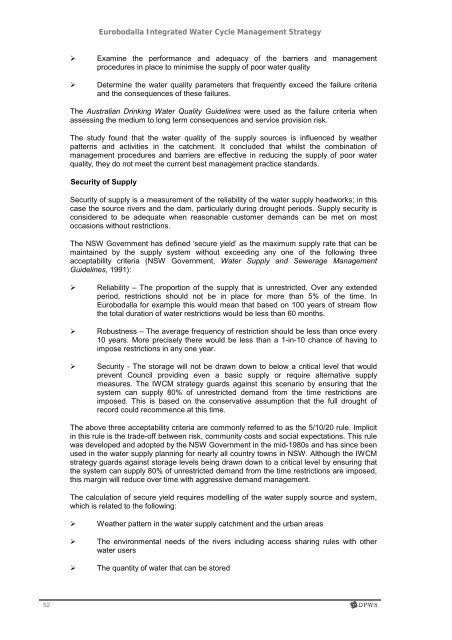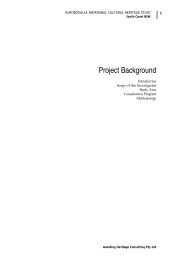Eurobodalla Integrated Water Cycle Management Strategy
Eurobodalla Integrated Water Cycle Management Strategy
Eurobodalla Integrated Water Cycle Management Strategy
Create successful ePaper yourself
Turn your PDF publications into a flip-book with our unique Google optimized e-Paper software.
52<br />
<strong>Eurobodalla</strong> <strong>Integrated</strong> <strong>Water</strong> <strong>Cycle</strong> <strong>Management</strong> <strong>Strategy</strong><br />
Examine the performance and adequacy of the barriers and management<br />
procedures in place to minimise the supply of poor water quality<br />
Determine the water quality parameters that frequently exceed the failure criteria<br />
and the consequences of these failures.<br />
The Australian Drinking <strong>Water</strong> Quality Guidelines were used as the failure criteria when<br />
assessing the medium to long term consequences and service provision risk.<br />
The study found that the water quality of the supply sources is influenced by weather<br />
patterns and activities in the catchment. It concluded that whilst the combination of<br />
management procedures and barriers are effective in reducing the supply of poor water<br />
quality, they do not meet the current best management practice standards.<br />
Security of Supply<br />
Security of supply is a measurement of the reliability of the water supply headworks; in this<br />
case the source rivers and the dam, particularly during drought periods. Supply security is<br />
considered to be adequate when reasonable customer demands can be met on most<br />
occasions without restrictions.<br />
The NSW Government has defined ‘secure yield’ as the maximum supply rate that can be<br />
maintained by the supply system without exceeding any one of the following three<br />
acceptability criteria (NSW Government, <strong>Water</strong> Supply and Sewerage <strong>Management</strong><br />
Guidelines, 1991):<br />
Reliability – The proportion of the supply that is unrestricted. Over any extended<br />
period, restrictions should not be in place for more than 5% of the time. In<br />
<strong>Eurobodalla</strong> for example this would mean that based on 100 years of stream flow<br />
the total duration of water restrictions would be less than 60 months.<br />
Robustness – The average frequency of restriction should be less than once every<br />
10 years. More precisely there would be less than a 1-in-10 chance of having to<br />
impose restrictions in any one year.<br />
Security - The storage will not be drawn down to below a critical level that would<br />
prevent Council providing even a basic supply or require alternative supply<br />
measures. The IWCM strategy guards against this scenario by ensuring that the<br />
system can supply 80% of unrestricted demand from the time restrictions are<br />
imposed. This is based on the conservative assumption that the full drought of<br />
record could recommence at this time.<br />
The above three acceptability criteria are commonly referred to as the 5/10/20 rule. Implicit<br />
in this rule is the trade-off between risk, community costs and social expectations. This rule<br />
was developed and adopted by the NSW Government in the mid-1980s and has since been<br />
used in the water supply planning for nearly all country towns in NSW. Although the IWCM<br />
strategy guards against storage levels being drawn down to a critical level by ensuring that<br />
the system can supply 80% of unrestricted demand from the time restrictions are imposed,<br />
this margin will reduce over time with aggressive demand management.<br />
The calculation of secure yield requires modelling of the water supply source and system,<br />
which is related to the following:<br />
Weather pattern in the water supply catchment and the urban areas<br />
The environmental needs of the rivers including access sharing rules with other<br />
water users<br />
The quantity of water that can be stored

















